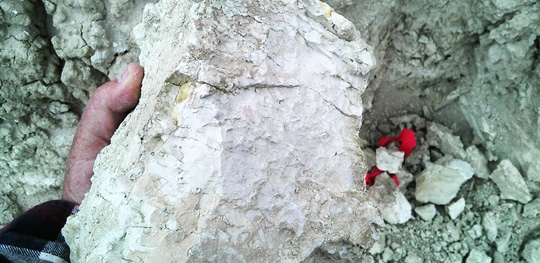Lithium in Claystones
Claystones are a new, unconventional source for lithium that have not yet been produced at scale anywhere in the world. Nonetheless, claystones promise to unlock vast new lithium resources within the next several years, particularly in territories that have little lithium production today, such as North America.
Like “hard rock”, the term “claystones” is an informal one. It refers to sedimentary rocks, which are rocks formed by layers of clay, silt, sand, and even organic material, compressed over millions of years. But not all sedimentary rock contains lithium.
To find lithium in sedimentary rocks today, you would have to find lithium-bearing hard rocks in the same vicinity millions of years before (these hard rocks would have been created by volcanos spewing lithium-imbued ash and lava, which then cooled into rock). Over time, the lithium-rich hard rocks were eroded by rain, flowing water, winds, and sun, and their lithium-bearing particles absorbed into the surrounding sediments, which eventually became sedimentary rock.

How Claystones Will Be Mined
Claystones will be mined similarly to hard rocks, but with some key differences. As with hard rock, miners will dig an excavation into the earth, but typically with a gentler touch. The claystone is like a layer cake near the surface, with lithium-rich layers stacked atop each other. Thanks to sedimentary rock’s softer nature, drilling and blasting is typically not necessary. Using bulldozers and scrappers can generally do the job of digging.
The material that’s excavated is then brought to a nearby processing plant, which takes a first pass at separating the lithium-bearing material from everything else — for instance, the rock material may be mixed with water, and placed in a centrifuge. The act of spinning separates heavier particles from lighter particles, with lithium concentrated in either batch, depending on its composition.
This concentrated, lithium-brearing material can now be moved to the next processing step. Unlike hard rock lithium, there is no energy-hungry roasting at over 1000 degrees. But after skipping over that energy-hungry step, claystone lithium follows a similar path — ie, the rock material is broken down with sulphuric acid, and different materials such as lime, limestone and soda ash are added to the mix in order to change the Ph level (acidity) of the solution and precipitate out unwanted elements until lithium itself can be precipitated.
Considerations
Lower Costs and Impact
Extracting lithium from claystones typically doesn’t require hard rock’s energy-intensive step of roasting the material to over 1000 degrees celsius. This significantly lowers energy costs and simplifies logistics. Comparing claystones to brines, claystone extraction is not expected to have the environmental impact (and growing political resistance) as brines do, where vast amounts of water must be pumped up from the water table and evaporated away.
Massive North American Deposits
To date, North America has not been blessed with productive lithium resources. It has has a single, small-scale brines mine (Albemarle’s Silver Peak project in NV). As for hard rock lithium, there are known pegmatite resources in a handful of areas, but no working mines, and only one site has mined lithium in the modern era, with a modest yield (at Kings Mountain, North Carolina). But lithium-bearing claystones are abundant on the continent, especially in the mining-friendly state of Nevada, as well as other states and Mexico. The deposits in Nevada alone can significantly contribute to the world’s future lithium supply, and give North American an opportunity to reduce dependency on foreign sources.

Greater Reclaimation
We expect many claystone excavations to be reclaimed and returned to their original state after mining. Since the mined material is sedimentary rock, it does not require the drilling, blasting and crushing of typical hard rock lithium operations coming out of Australia. What’s more, presently, Australia, as the world’s leader in hard rock lithium mining, ships its mined material to China for advanced processing, which means the material is no longer available to fill in an open pit. But with clay stone mining, much of the extracted rocks will be nearby can be pushed back into the exavation when mining is finished, reclaiming the area’s natural state to a far greater degree.
Lower Grades Across Larger Deposits
Claystones typically have lower grades of lithium than hard rocks. Any given claystone sample may typically have .1% to .25% lithium, compared to hard rocks that might bear up to 5% lithium. But the lithium found in claystones is typically disseminated across a broad deposit (sometimes kilometers wide and tens of feet thick), whereas high-grade lithium in hard rock may exist only in pegmatite dykes of 10-30 ft, and then disappear beyond that very localized area. We believe that lower-grade lithium in claystones will eventually follow the development path of disseminated gold in the U.S, which was new and unfamiliar, and is now the dominant form of gold mining in the U.S.
Noteworthy Projects
• Tonapah, NV (American Lithium)
• Thacker Pass, NV (Lithium Americas)
